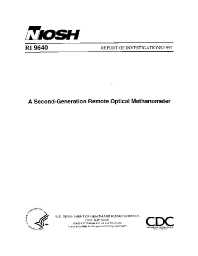Mining Publication: A Second-Generation Remote Optical Methanometer
Original creation date: May 1997
As the use of deep-cut mining increases, there is expected to be a greater demand for methane (CH4) measurement devices capable of scanning working faces at depths in excess of 10 m to alert mine personnel of hazardous concentrations of methane and to satisfy regulatory requirements. Remote optical devices offer the most promise to satisfy these objectives while the operator remains safely under supported roof. A second generation remote optical methanometer (ROM) has been designed and is undergoing laboratory evaluation at the National Institute for Occupational Safety and Health. It operates on the principle of the "u3" fundamental absorption band of CH4 centered at 3.31 µm in the infrared region off the spectrum. The new instrument differs from the previous prototypes by the replacement of the two-band pass differential absorption technique of measurement with a single-filter gas correlation technique and a refinement of the amplifier and gating circuitry used within the unit. This results in a more accurate isolation of the CH4 spectral absorption band centered at 3.31 µm. A specially designed 0.4-m-diam variable length gas mixing tunnel was constructed and instrumented with CH4-sampling capability to calibrate the ROM. Experiments have demonstrated the ability of the detector to respond to various conditions of CH4 (pct * m) at distances as great as 12 m. Thermal radiation generated within the instrument is the controlling factor in the drift of the output signal and, therefore, the reliability of the instrument. Several approaches to reduce this extraneous radiation interfering with the infrared detector are described, such as installation of a fan in the instrument and thermoelectric coolers on the detector's heat sink. Implementations of the technology will significantly improve the safety of miners.
Authors: RA Franks, JJ Opferman, GF Friel, JC Edwards
Report of Investigations - May 1997
NIOSHTIC2 Number: 00238252
Pittsburgh, PA: U.S. Department of Health and Human Services, Public Health Service, Centers for Disease Control and Prevention, NIOSH, DHHS (NIOSH) Publication No. 97-126, Report of Investigations 9640, 1997 May; :1-9
See Also
- Cableless Electronic Surveying Systems for Horizontal Holes
- Evaluation of IYONI II Methanometers
- Evaluation of Person-Wearable Methane Monitors
- Factors Affecting the Location of Methanometers on Mining Equipment
- Ignition of Methane-Air Mixtures by Laser Heated Small Particles
- Methane Emission Rate Studies in a Northern West Virginia Mine
- Remote Fiber-Optic Methane Monitor
- Remote Methane Sensors
- Use of a Test Box to Measure Response Times for Machine-Mounted Monitors
- Use of Infrared Sensors for Monitoring Methane in Underground Mines
- Page last reviewed: 9/21/2012
- Page last updated: 9/21/2012
- Content source: National Institute for Occupational Safety and Health, Mining Program


 ShareCompartir
ShareCompartir
